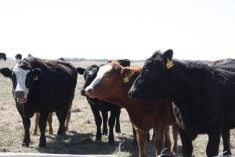This cattle market information is selected from the weekly report from Canfax, a division of the Canadian Cattle Association. More market information, analysis and statistics are available by becoming a Canfax subscriber by calling 403-275-5110 or at www.canfax.ca.
Packers have plenty
Steer cash trade surfaced Dec. 20 in both Alberta and Ontario. In Alberta, the weighted average price was $219.23 per hundredweight live, down $1.61 per cwt. from the previous week. Dressed trade was reported from $361.50-$362.75 per cwt. f.o.b., $3.75-$7 per cwt. lower than the previous week. Packers are well positioned with cattle well into the new year.
Read Also

VIDEO: Ag in Motion documentary launches second season
The second season of the the Western Producer’s documentary series about Ag in Motion launched Oct. 8.
Steer carcass weights in the West as of Dec. 22 were 983 pounds, re-establishing a new all-time high and are two lb. heavier than the previous week.
Over the last three weeks of December, steer carcass weights increased 28 lb. Carcass weights have historically begun to move lighter through November and December, but that hasn’t happened this year; exceptional feedlot pen conditions have improved performance.
Feedlots are looking to move heavier cattle as soon as hook spaces open up. Depending on the packer, weight break discounts are at 1,050-1,100 lb.
Fed slaughter in the third week of December totalled 53,926 head, seven percent higher than the previous week. Year-to-date fed slaughter volumes totalled 2,539,809 head, six percent lower than last year. Western fed slaughter totalled 2,039,853 head, down six percent from last year and steady with the five-year average.
In Ontario, the weighted average steer price was $224.49 per cwt., down $2.61 per cwt. from the week ending Dec. 15. Dressed prices were $373.50-$375.50 per cwt. f.o.b., down $3-$5 per cwt. from the previous week.
In the United States, trade was at a standstill as of Dec. 21. Mid-week bids of US$170 per cwt. live and $270 per cwt. dressed were renewed Dec. 22, but packers had to raise bids by $1 per cwt. to garner any interest.
For the week ending Dec. 23, U.S. beef production was estimated at 524.3 million lb., 4.1 percent lower than the same week last year. Slaughter volumes were 4.3 percent lower and carcass weights were 846 lb.
Cows on good note
The western Canadian cow market ended the year on a better note than the fed market. The week ending Dec. 22 was the last full week for packers and feeder cow buyers to procure cows through the ring before the holidays, and prices were mostly steady.
Butcher cows averaged in the upper $120s per cwt. for the first three weeks of December. D2s averaged $128.42 and D3s averaged $113.92 per cwt. as of Dec. 22.
Last month, Alberta cow prices went from a $10 per cwt. discount to the U.S. market to trading par. For the week ending Dec. 16, Canadian cows accounted for 18.3 percent of total slaughter compared to the three-year average of 16.8 percent.
Butcher bull export volumes remain historically low for this time of the year. Year-to-date Canadian bull slaughter is 27 percent larger than last year while bull export volumes are down 18 percent. This year Canadian bull slaughter is on track to be the largest since 2011.
Bull calves wanted
The week ended Dec. 22 saw quite a few bull calves and lightweight heifers on offer. In certain spots demand for bull calves weighing 425-550 lb. seemed relatively strong.
In general, the bull calf discount (compared to steers) seemed smaller than normal. The bull calf market was supported by grass buyers. Over the past month, the largest price decline has been on 300-400 lb. calves with prices dropping $12-$18 per cwt.
The steer-heifer price spread on lighter weight calves narrowed considerably in December. In November, the 450 lb. steer-heifer price spread was record large, averaging $86 per cwt. Near the end of December, the 450 lb. steer-heifer price spread was closer to $68.
For October, Canadian imports of U.S. feeder cattle totalled slightly less than 37,000 head, 23 percent lower than last year. Year to date, Canada is a net importer of U.S. feeder cattle by 136,500 head. Bred cow and heifer prices were down $150-$200 per head. In late December, Alberta bred cows traded from $2,000-$3,500 per head, averaging $2,700. Bred cows traded $900 per head higher than last year. Bred heifers were reported up to $4,200 per head, averaging $3,100.
U.S. cutouts steady
In U.S. beef trade, Choice cutouts closed the week of Dec. 22 at US$291.13 per cwt., steady with the previous week. Select cutouts rebounded one percent higher to $261.27.
















